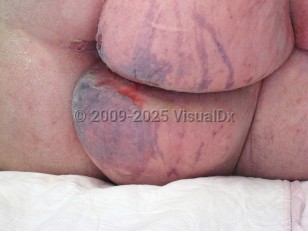These changes indicate damage to the underlying deep tissue from pressure and shear. Typical sites of deep tissue injury are the sacrum and the heels. A primary cause of deep tissue injury is immobility in combination with the following factors: pressure, shear friction, and moisture.
Other risk factors that predispose to deep tissue injury include incontinence, nutritional deficits, old age, altered mental status, and malnutrition. Depending on these factors, a pressure injury may begin to develop in as little as 20 minutes.
When examining the injury, observe the following points:
- Location on the body
- Stage of the ulcer
- Size of the ulcer, which should include width and length in centimeters
- Wound edges – Look carefully at the edge of the ulcer for evidence of induration, maceration, rolling edges, and redness.
- Skin around the edges of the ulcer – The periwound skin should be assessed for color, texture, temperature, and integrity of the surrounding skin.
- Presence or absence of pain
- Odor, if present or absent
- Medical device-related pressure injury (describes an etiology) – Results from the use of devices designed and applied for therapeutic purposes. Injury generally conforms to the pattern or shape of the device. Stage using the staging system.
- Mucosal membrane pressure injury – Found on mucous membranes with a history of a medical device in use at the location of the injury. Cannot be staged due to anatomy of tissue.



